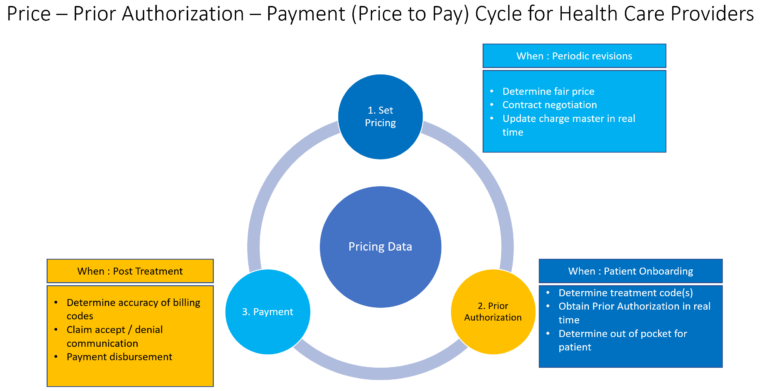Orchestrating Real-Time Healthcare Billing Workflows

The PPP (Price, Prior Authorization, Payment) Cycle in Health care
Hospital CFOs deal with imperfect systems on a day-to-day basis because the systems that are in place at most hospital systems have not been designed for healthcare operations. Hospitals run of EHRs. However, by their very nature EHRs are Electronic Health Record systems and are not designed to handle the intricacies of Hospital Healthcare Operations. For example, EHRs are not designed for Financial Planning and Forecasting, they are not designed to automate Revenue Cycle Management in healthcare and they are not designed to handle a number of other sub-systems such as staff forecasting, inventory planning and replenishment, and supplier management.
Due to the lack of a consistent ERP system that can drive the entire healthcare operation, CFOs need to handle a number of tasks via manual processes.

Let us start the discussion with pricing. Hospitals have a number of parameters than can use to set pricing. Fair price determination can be tied for example to Medicare reimbursement for a CPT, HCPCS, or DRG code. A typical guideline could be that the price needs to be within a certain percentage (for example 130%) of the Medicare price. Determining the cost of a certain procedure for the hospital drives setting up the gross price for the procedure. However, without a lack of competitive data, the CFOs team would be setting up prices without a lot of insights they would need. For example, if the team had access to regional and state averages for the prices of the codes, that would be immensely helpful. Similarly, when prices change in the area, alerts on the price changes in a set of codes in a category could potentially trigger a re-evaluation on behalf of the hospital. In addition to the prices for the other providers, knowing reimbursement rates from several payers would be immensely helpful to the hospital system and they could factor these data points into the price determination. Setting up the price too high could put an undue burden on the patients and invite pushback from the payers. Setting up the prices too low could set the margins low or even negative. A robust financial modeling tool for the pricing process is needed for CFOs to make a good determination of the pricing structure.
The next step in the cycle is prior authorization. This happens just before or at the start of the patient visit. Hospital systems typically need to call payers to get prior authorization. Payers would check on the plan the patient has presented along with any other co-insurance companies, the amount of copay involved, and the amount of reimbursement. This would help the hospital system determine the out-of-pocket expense for the patient and the amount of insurance reimbursement they can expect from the payers. Having this step as a manual step is a cost to the hospital and makes it error-prone. If the charge master and payer reimbursement models are available to the hospital in real-time that can simplify this process.
The final step is the payment process. Hospitals typically submit charge codes such as CPT, HCPCS, and DRG codes along with the needed documentation. Due to the manual processes involved in the coding and billing process hospital systems often under code charges. Further, the billing is submitted to a clearing house and not the payer themselves. When the payment clears that is often transmitted to the hospital from the payer and there is no automated reconciliation between the billing process and the payment process. If the amounts that are allowed for each of the billing codes are known in real-time and are checked automatically, errors in the submission process can be cut down. In addition, if AI models can be trained on past claims, under-coding can be avoided as the AI models can look over the shoulder of the billing personnel and potentially inject suggestions and comments, creating an automated copilot for the billing team.
The PPP cycle for healthcare is complex but several new developments auger well for the industry. Oracle coming into the arena brings in hope that Oracle can integrate the Fusion Cloud ERP solution with the Cerner EHR and provide a true enterprise solution for hospital systems. The democratization of AI also augers well as leveraging AI in the pricing, pre-auth, and billing processes can help alleviate a lot of pain felt by the Hospital System CFOs and COOs.
CloudAstra’s Data As A Service which provides real-time prices via curated Healthcare Price Transparency data can be plugged into several of these processes using convenient APIs. If you are providing solutions in these areas, please reach out to us to know more.
We would love to collaborate with you. https://cloudastra.ai/contact-us/
